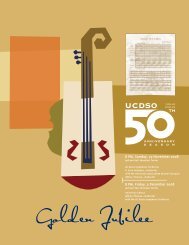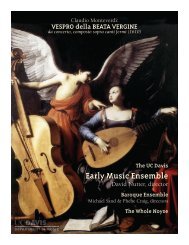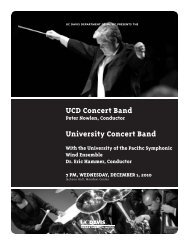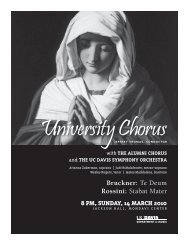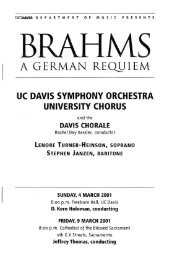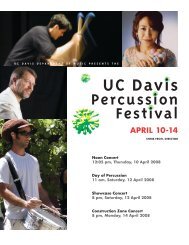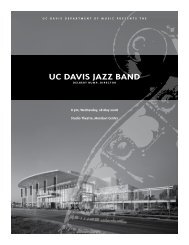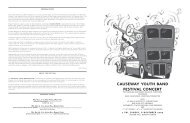8 pm, Sunday, February 6, 2011 Christian Baldini - UC Davis ...
8 pm, Sunday, February 6, 2011 Christian Baldini - UC Davis ...
8 pm, Sunday, February 6, 2011 Christian Baldini - UC Davis ...
Create successful ePaper yourself
Turn your PDF publications into a flip-book with our unique Google optimized e-Paper software.
THE <strong>UC</strong> DAVIS DEPARTMENT OF MUSIC PRESENTS THE<br />
<strong>Christian</strong> <strong>Baldini</strong>, music director and conductor<br />
D. Kern Holoman, conductor emeritus<br />
8 <strong>pm</strong>, <strong>Sunday</strong>, <strong>February</strong> 6, <strong>2011</strong><br />
Jackson Hall, Mondavi Center
SUNDAY, FEBRUARY 6, <strong>2011</strong><br />
8PM, JACKSON HALL, MONDAVI CENTER<br />
<strong>UC</strong> DAVIS SYMPHONY ORCHESTRA<br />
CHRISTIAN BALDINI, MUSIC DIRECTOR AND COND<strong>UC</strong>TOR<br />
D. KERN HOLOMAN, COND<strong>UC</strong>TOR EMERITUS<br />
WITH<br />
ANDREA SEgAR, VIOLIN, AND DAVID RUSSELL, CELLO<br />
PROgRAM<br />
Concerto for Violin, Cello, and Orchestra in A Minor, op. 102 Johannes Brahms<br />
Allegro (1833–97)<br />
Andante<br />
Vivace non troppo<br />
Andrea Segar, violin<br />
David Russell, cello<br />
D. Kern Holoman, conductor<br />
INTERMISSION<br />
Symphony No. 7 in C Major, op. 105 (in one movement) Jean Sibelius<br />
Adagio—Vivacissimo—Presto—Largamente (1865–1957)<br />
<strong>Christian</strong> <strong>Baldini</strong>, conductor<br />
At the conclusion of tonight’s performance please join Andrea Segar, David Russell, and<br />
members of the orchestra in the Yocha Dehe Grand Lobby (the ground floor).<br />
We ask that you be courteous to your fellow audience members and the performers. Please turn off your cell phones and refrain from texting. Audience members<br />
who are distracting to their neighbors or the performers in any way may be asked to leave at any time. Also, this performance is being professionally recorded for<br />
the university archive. Photography, audio, or audiovisual recording is prohibited during the performance.
For violin and cello solo;<br />
flutes I-II, oboes I-II,<br />
clarinets I-II, bassoons I-II;<br />
horns I-IV; trumpets I-II;<br />
timpani; strings<br />
Published by N. Simrock<br />
(Berlin, 1888)<br />
Duration: about 35 minutes<br />
For flutes I-II, oboes I-II,<br />
clarinets I-II, bassoons I-II,<br />
horns I-IV; trumpets I-III;<br />
trombones I-III, timpani; strings<br />
Published by Wilhelm Hansen,<br />
1925<br />
Duration: about 25 minutes<br />
4<br />
NOTES<br />
Cellist Robert Hausmann commissioned Johannes Brahms to write a Double Concerto in<br />
an attempt to reconcile the composer with his former companion-at-arms, the celebrated<br />
violinist Joseph Joachim. Composed during the summer of 1887, the work was given a<br />
private reading at Clara Schumann’s villa in Baden-Baden on 23 September 1887, then<br />
offered to the public on 18 October in nearby Cologne, with Joachim and Hausmann as<br />
soloists and the composer conducting. The Concerto for Violin, Cello, and Orchestra in<br />
A Minor, op. 102, was Brahms’s last orchestral composition.<br />
Brahms professed to be uncomfortable with the idea of composing for the two solo string<br />
instruments, yet he managed the two-in-one situation splendidly, with duos, solos, pursuits,<br />
extremes of the high violin and low cello, and, more interestingly, intersections of the high<br />
range of the cello with the low of the violin. The concerto’s particular color—its play of light<br />
and shadow—results in part from the A-minor key but mostly from the unique choice of solo<br />
instruments. There is a new concision carefully nourished since his Fourth Symphony.<br />
The Allegro opens with a four-measure tutti. A recitative for the solo cello is extended by<br />
the winds in the entry of the solo violin, and together the soloists work through what is<br />
the only serious cadenza in the concerto. The full orchestra exposition of themes follows,<br />
commencing from the material with which the work opened and strong on triplet gestures.<br />
Once the soloists return they dominate the movement. Their first statement peters out;<br />
after an empty measure, the secondary key is reached and the cello states the new theme,<br />
rich with peaks and musings. The violin turns this material to more conclusive purpose,<br />
and the exposition ends in great wedgings in and out of the soloists: first a strongly marked<br />
tumble with violin double-stops, then the soloists alight on the same pitch and stretch<br />
outward in long, smooth syncopation. Much is made of this figure, especially at the end of<br />
the develo<strong>pm</strong>ent. The recapitulation slides into the major mode, and the coda thrusts it back<br />
into minor.<br />
The Andante begins with a horn call and its echo, to establish the new key area of D major.<br />
Throughout the continuously evolving theme the soloists double each other at the octave.<br />
The second section lifts in key and register and is primarily a passage for woodwinds<br />
ornamented by the soloists. The Vivace is a strong rondo with a range of sonorities that<br />
fluctuates from the skeletal to the familiar Brahmsian abundance, as in the glorious second<br />
theme begun in the solo cello. After the first big section winds down chromatically, new<br />
material reminiscent of a melody from the Academic Festival Overture is heard from the<br />
soloists, succeeded by an episode for clarinets and bassoons in a long chain of syncopations.<br />
Then the way is cleared for the return of the opening material and a reflection before the<br />
inevitable vigor of the closing measures of music.<br />
—D. Kern Holoman<br />
Jean Sibelius, Symphony No. 7 in C Major, op. 105 (revised 1980 Hansen edition). There<br />
are numerous examples of musicians who initially trained in different professions other than<br />
music. One may think of Herbert von Karajan as a young engineering major, or Pierre Boulez<br />
pursuing a degree in mathematics. There are also a number of composers who trained to<br />
become lawyers. Among these, one must point out Tchaikovsky, Stravinsky, and Sibelius.<br />
Jean Sibelius, arguably the most important composer of Finland, lived a very long<br />
life (1865–1957). He established himself as a prominent symphonist of the twentieth<br />
century, and most major orchestras throughout the world have recorded his works. He<br />
composed his First Symphony at age thirty-three and his last, the Seventh Symphony, at<br />
age fifty-nine, in 1924. After this symphony, Sibelius wrote only four other works: The<br />
Tempest (incidental music, 1925), Väinö’s Song (for chorus and orchestra, 1926), Tapiola<br />
(tone poem, 1926), and the famous Andante Festivo (a 1938 arrangement of a String Quartet<br />
from 1922). In short, he lived the last thirty-one years of his life without composing any<br />
new music. He had plans and sketches for an Eighth Symphony, which he had promised<br />
to Serge Koussevitzky for a premiere in 1931, and again in 1932. He also intended the new<br />
symphony to be finished in 1933 for Basil Cameron, the English conductor who would<br />
become the Music Director of the San Francisco Symphony. But the Eighth Symphony
NOTES<br />
never came out of Sibelius’s desk. In fact, no manuscript of any of the sketches survives.<br />
Sibelius himself said, “If I cannot write a better symphony than my Seventh, then it shall<br />
be my last.” His wife, Aino, recalled that in the 1940s “my husband collected a number of<br />
manuscripts in a laundry basket and burned them on the open fire in the dining room. . . .<br />
I did not have the strength to be present and left the room. I therefore do not know what he<br />
threw on to the fire. But after this my husband became calmer and gradually lighter in mood.”<br />
The Seventh Symphony is extremely original and luminous. It is written in the key of C<br />
major, which was a rather daring statement in 1924, since tonality had been destroyed for<br />
nearly two decades, and composers tended to think that nothing new could be said in this<br />
key. The composer Ralph Vaughan Williams remarked that “only Sibelius could make C<br />
major sound completely fresh.”<br />
The idea that innovation and conservatism are total opposites in a specific music era is a<br />
truly simplistic statement. There is a constant interaction between these two concepts in<br />
such parameters as form, style, technique, rhythm, and expression. Two great examples to<br />
consider are Brahms and Schoenberg. Simplistically speaking, one could say that Brahms<br />
was conservative and Schoenberg an innovator. One could also argue that Brahms was<br />
incredibly original and truly revolutionary in his use of rhythmical structures and in the<br />
sense of where he took the symphonic world. One could also add that Schoenberg was<br />
highly conservative in his approach to form. Composers in general make use of both,<br />
innovation and conservatism. There exists a certain balance between them.<br />
Sibelius wrote music that was entirely sincere and natural to his heart, but to others, his<br />
harmonic language seemed often restrained and conservative, compared to many of his<br />
contemporaries who were clearly experimenting with musical Modernism. Three composers<br />
who influenced him deeply were Wagner (Sibelius attended a performance of Parsifal in<br />
Bayreuth), Tchaikovsky, and Bruckner. One striking feature of Sibelius’s music results from<br />
his progressively stripping away the formal markers of sonata form in his works. Instead<br />
of multiple themes that contrast with one another, he focused on the idea of organic,<br />
continuously evolving cells and motives. His music is episodic, yet the elements follow<br />
one another in a nonconventional way. The Symphony No. 7 presents a paradigm of this<br />
procedure, which builds a large form out of a number of episodes that eventually intertwine.<br />
Even though it consists of different movements, it is performed with no interruptions, in a<br />
similar way to Schumann’s Fourth Symphony. In Schumann’s case, the movements follow<br />
one another without interruptions, yet the movements themselves are completely closed<br />
forms. In Sibelius’s case, the whole piece is a closed form, with no smaller entities that can<br />
be separated. The transitions are smooth and natural, rather than angular and well defined.<br />
In short, they resemble those found in nature but not questioned, just like a tree growing out<br />
of the ground, for example. The transitions themselves become an essential part of the work<br />
rather than a bridge from one place to another.<br />
The Seventh Symphony has one of the most remarkable endings ever written. It is perhaps<br />
the most tragic—and yet hopeful!—way of resolving to a C-major chord in music history.<br />
The entire work is a great example of an ever-changing behavior. Sibelius’s way of asking<br />
for changes is by negation. In the score, he often notates “poco a poco meno Adagio” (little<br />
by little less slow), or “poco a poco meno moderato” (little by little less moderate), instead of<br />
the more traditional indication “poco a poco più mosso” (little by little faster). Usually these<br />
changes take place over a long time and so they need to happen very gradually, a process<br />
that is in complete harmony with his “organic” method of building the form itself. Over<br />
time, all things evolve into something else, in a very subtle way. Sibelius described his own<br />
understanding of this process very well when he said: “I love the mysterious sounds of the<br />
fields and forests, water and mountains. . . . It pleases me greatly to be called an artist of<br />
nature, for nature has truly been the book of books for me.”<br />
—<strong>Christian</strong> <strong>Baldini</strong><br />
5
6<br />
ABOUT THE ARTISTS<br />
<strong>Davis</strong> native Andrea Segar, violin, has appeared internationally as a soloist and chamber<br />
musician. She studied at the San Francisco Conservatory of Music Preparatory Division,<br />
where she won the Heifetz Violin Competition for three consecutive years and was granted<br />
the use of the “Heifetz ex-David” Guarneri del Gesu violin for recitals at the San Francisco<br />
Palace of the Legion of Honor. Segar’s other awards include first prizes in the Washington<br />
International String Competition and the American String Teachers Association National<br />
Solo Competition, second prize and the “Most Promising Talent” award in the California<br />
International Young Artists Competition, and two first prizes in the Pacific Musical Society<br />
Competition. Segar is also a past recipient of a Williamson Foundation festival grant and a<br />
Dorothy Richard Starling scholarship. Her performances have been broadcast on National<br />
Public Radio, Vermont Public Radio, and WGBH Boston.<br />
Segar has appeared as soloist with ensembles across the country, including the Oakland-<br />
East Bay Symphony, Desert Hills Musicfest Festival Orchestra, ProArt Symphony, and New<br />
England Conservatory Bach Ensemble, in such prestigious venues as the Kennedy Center in<br />
Washington, D.C. and Jordan Hall in Boston. She also appears at international music festivals<br />
including IMS Prussia Cove (Cornwall, United Kingdom), Festival de San Miguel de Allende<br />
(Mexico), and the Bedford Chamber Music Festival (United Kingdom) and as a chamber<br />
musician in festivals including the Olympic Music Festival, Music at Menlo, Music Academy<br />
of the West, Jigsaw Players (United Kingdom), Yellow Barn Music Festival, and the Chamber<br />
Music Society of Sacramento. Recent chamber music collaborations include performances<br />
with the Doric Quartet, members of the Peabody Trio and Mendelssohn Quartet, Jean-Michel<br />
Fonteneau, Peter Frankl, Grammy award-winning artists Roger Tapping and Susan Narucki,<br />
and members of the London Philharmonic Orchestra.<br />
Segar received her B.M. and M.M. with honors from the New England Conservatory of<br />
Music, where she served as the teaching assistant to violin professor Donald Weilerstein. She<br />
was previously on the violin faculty in the New England Conservatory Preparatory Division<br />
and now resides in New York and serves as the head violin teaching assistant at SUNY<br />
Stony Brook. She is thrilled to return to the Mondavi Center after having given the first solo<br />
performance in Jackson Hall in October of 2002.<br />
David Russell, cello, is a busy Boston area performer who has also toured extensively in<br />
France, Germany, Italy, and England. Russell last performed with the <strong>UC</strong> <strong>Davis</strong> Symphony<br />
Orchestra for Laurie San Martin’s Cello Concerto premiere in 2007. He was assistant<br />
principal cellist with the Tulsa Philharmonic, faculty member at Oklahoma City University<br />
from 2001 to 2003, a member of the Grammy-nominated Eaken Trio, formerly in residence<br />
at Dickinson College, and played principal cello with Opera Boston and the Hingham<br />
Symphony. Regular appearances include Pro Arte Chamber Orchestra of Boston, the New<br />
England String Ensemble, Cantata Singers and Ensemble, and Emmanuel Music. A strong<br />
advocate of new music, he has performed with Phantom Arts Ensemble for American Music,<br />
Dinosaur Annex, Collage New Music, Boston Modern Orchestra Project, Music on the Edge,<br />
AUROS Group for New Music, Firebird Ensemble, the Cleveland Chamber Symphony, Stony<br />
Brook Contemporary Chamber Players, and the Fromm Foundation Players at Harvard.<br />
He is a founding member of Furious Band, an ensemble devoted to the exploration and<br />
performance of works by young composers. His recent projects include the premiere of<br />
Ricardo Zohn-Muldoon’s chamber opera “Comala” in Mexico City, performances at Miller<br />
Theater at Columbia University, the American Academy in Rome and the Rotterdam<br />
Conservatory, U.S. premieres of works for solo cello by Harold Meltzer and Judith Weir,<br />
master classes at the University of California, <strong>Davis</strong>, University of Wisconsin-Madison, and<br />
University of Alaska-Fairbanks and residencies at the University of South Carolina-Columbia<br />
and Tufts University. He was appointed to the Wellesley faculty in 2005.<br />
Russell earned his D.M.A. in cello performance at the State University of New York at Stony<br />
Brook, studied with Timothy Eddy, and holds degrees from Eastman School of Music,<br />
University of Akron, and Brandeis University. He has studied with Steven Doane, Michael<br />
Haber, and Rhonda Rider. His recordings include new works by Eric Moe, Eric Chasalow,<br />
Laurie San Martin, Allen Anderson, and Edward Knight, on Albany Records, New World<br />
Records, and Composers Recordings labels.
ABOUT THE ARTISTS<br />
Educated at Duke and Princeton Universities, D. Kern Holoman joined the faculty of<br />
<strong>UC</strong> <strong>Davis</strong> in 1973 and has taught music history and orchestral performance here ever<br />
since. He was founding Dean of Humanities, Arts and Cultural Studies at <strong>UC</strong> <strong>Davis</strong>; the<br />
first Barbara K. Jackson Professor of Orchestral Conducting; and the fourth conductor<br />
of the <strong>UC</strong> <strong>Davis</strong> Symphony Orchestra, from 1977 to 2009. Among Holoman’s scholarly<br />
books and articles are the Catalogue of the Works of Hector Berlioz (Bärenreiter, 1987),<br />
Berlioz (Harvard University Press, 1989; Faber & Faber, 1990), the Société des Concerts<br />
du Conservatoire, 1828–1967 (University of California Press, 2004), and the forthcoming<br />
Charles Munch (Oxford University Press, <strong>2011</strong>). His books for students and the general<br />
public include Evenings with the Orchestra: A Norton Companion for Concertgoers (Norton,<br />
1992), Masterworks, a multimedia textbook package (Prentice Hall/Simon & Schuster,<br />
1998; e-book, 2010), Writing about Music (<strong>UC</strong> Press, 1988; rev. 2nd edn. 2008), and The<br />
Orchestra: A Very Short Introduction (Oxford UP, <strong>2011</strong>). In November 2010 Holoman was<br />
named Honorary Member of the American Musicological Society, in recognition of his<br />
career in music scholarship and service to the organization.<br />
The dynamic work of <strong>Christian</strong> <strong>Baldini</strong>, conductor and composer, has taken him around<br />
the world as a guest conductor with the Buenos Aires Philharmonic (Argentina), the San<br />
Francisco Contemporary Music Players, conducting opera for the Aldeburgh Festival<br />
(United Kingdom), and as a featured composer at the Acanthes Festival in France. After<br />
he conducted the Sao Paulo Symphony Orchestra (OSESP, Brazil), critic Arthur Nestrovski<br />
from the Folha de Sao Paulo praised this “charismatic young conductor” who “conducted by<br />
heart Brahms’s First Symphony, lavishing his musicality and leaving sighs all over the hall<br />
and the rows of the orchestra.”<br />
<strong>Baldini</strong>’s music has been performed throughout Europe, South America, North America,<br />
and Asia by orchestras and ensembles including the Orchestre National de Lorraine<br />
(France), Southbank Sinfonia (London), New York New Music Ensemble, Memphis<br />
Symphony Orchestra, Daegu Chamber Orchestra (South Korea), Chronophonie Ensemble<br />
(Freiburg), and the International Ensemble Modern (Frankfurt). His music appears on the<br />
Pretal Label and has been broadcast on SWR (German Radio) as well as in the National<br />
Classical Music Radio of Argentina. He has also conducted and recorded contemporary<br />
Italian music for the RAI Trade label.<br />
<strong>Baldini</strong>’s work has received awards in several competitions including the top prize at<br />
the Seoul International Competition for Composers (South Korea, 2005), the Tribune of<br />
Music (UNESCO, 2005), the Ossia International Competition (Rochester, NY, 2008), the<br />
Daegu Chamber Orchestra International Competition (South Korea, 2008), and the Sao<br />
Paulo Orchestra International Conducting Competition (Brazil, 2006). He has been an<br />
assistant conductor with the Britten-Pears Orchestra (England) and a cover conductor<br />
with the National Symphony Orchestra (Washington, D.C.). After teaching and<br />
conducting at the State University of New York in Buffalo, <strong>Baldini</strong> is now an assistant<br />
professor at the University of California, <strong>Davis</strong>, where he serves as the Music Director<br />
of the <strong>UC</strong> <strong>Davis</strong> Symphony Orchestra. He regularly appears as a guest conductor with<br />
ensembles and orchestras throughout South America and Europe. Forthcoming projects<br />
include performances with the Israel Contemporary Players and Ensemble Plural<br />
(Spain), and conducting engagements with the BBC Symphony Orchestra in London.<br />
7
Violin I<br />
Shawyon Malek-Salehi,<br />
concertmaster *<br />
Drew Cylinder *<br />
Jonathan Chan *<br />
Sophie Tso *<br />
Margaux Kreitman<br />
Maya Abramson<br />
Raphael Moore *<br />
Hewett Lan<br />
Alex Milgram<br />
Hannah Chung<br />
Vanessa Rashbrook<br />
Clairelee Bulkley *<br />
Victoria Wu<br />
Meghan Teague<br />
Ye Chen<br />
Violin II<br />
Cynthia Bates,<br />
principal *<br />
Tulin Gurer,<br />
assistant principal *<br />
Sharon Inkelas<br />
Emily Crotty<br />
Rachel Ferris<br />
Francisco Ortega<br />
Jason Lee<br />
Lisa Cheung<br />
Morgan McMahon<br />
Stephanie Hartfield<br />
Christina Mao<br />
Kathryn Azarvand<br />
Vi Truong<br />
8<br />
<strong>UC</strong> DAVIS SYMPHONY ORCHESTRA<br />
<strong>Christian</strong> <strong>Baldini</strong>, music director and conductor<br />
Abby Green, general manager<br />
Caitlin Murray, librarian<br />
Viola<br />
Andy Tan,<br />
principal *<br />
Caitlin Murray,<br />
assistant principal *<br />
Meredith Powell, *<br />
assistant principal<br />
Andrew Benson<br />
Giuliana Conti<br />
Matthew Slaughter<br />
Alice Chou<br />
Margaret Hermle<br />
Michaela Duyar<br />
Cello<br />
Isaac Pastor-Chermak,<br />
principal *<br />
Stephen Hudson *<br />
Carolyn Anderson *<br />
Han-ah Sumner *<br />
Chris Allen<br />
Rachel Baek<br />
Tobias Munch<br />
Paul Phillips<br />
Jimmy Yo<br />
Double Bass<br />
Melissa Zerofsky,<br />
principal *<br />
Thomas Mykytyn<br />
David Sachs<br />
Alex Keeve<br />
Thomas Adams-Falconer<br />
Names appear in seating order.<br />
Flute<br />
Abby Green,<br />
principal *<br />
Chris Brown *<br />
Edith Yuh<br />
Jonathan Martinez<br />
Oboe<br />
Sunaina Kale,<br />
principal *<br />
Stacey Habroun,<br />
co-principal<br />
Britney Satow<br />
Russell Eisenman<br />
Clarinet<br />
Robert Brosnan,<br />
principal *<br />
Aaron Hill,<br />
co-principal<br />
Thomas Ivy<br />
John Park<br />
Bassoon<br />
Adam Taylor,<br />
principal *<br />
Diane Royalty<br />
Allison Peery<br />
Matt Wong,<br />
co-principal and<br />
contrabassoon<br />
Horn<br />
Bobby Olsen,<br />
principal *<br />
Grant Fjastad<br />
Adam Morales,<br />
co-principal<br />
Katherine McLain<br />
FOR <strong>UC</strong> DAVIS DEPARTMENT OF MUSIC EVENTS<br />
Phil Daley, publicity manager<br />
Josh Paterson, production manager<br />
Christina Acosta, editor<br />
Rudy Garibay, designer<br />
Trumpet<br />
Andrew Neish,<br />
principal *<br />
Angelica Cortez,<br />
principal *<br />
Dillon Tostado<br />
Ben Hiebert<br />
Trombone<br />
Sean Raley,<br />
principal *<br />
Ethan Rosenberg *<br />
Nicole Tanner<br />
Bass Trombone<br />
John Matter *<br />
Tuba<br />
Adam Brover *<br />
Percussion<br />
Wyatt Harmon,<br />
section leader *<br />
Dan Eisenberg<br />
Victor Nava<br />
Kevin Barr<br />
Kevin Sakamoto<br />
Harp<br />
Emily Ricks,<br />
principal *<br />
Brittany Huynh<br />
Piano/Celesta/Organ<br />
Peter Kim *<br />
* Holder of endowed seat.
Shawyon Malek-Salehi – Cynthia Bates concertmaster<br />
Presented by Debra Horney, M.D.<br />
Drew Cylinder – Damian Ting assistant concertmaster<br />
Presented by Damian Siu Ming Ting<br />
Clairelee Leiser Bulkley – Clairelee Leiser Bulkley violin I<br />
Presented by Clairelee Leiser Bulkely & Ralph E. Bulkley<br />
Jonathan Chan – Francis Dubois violin I<br />
Presented by Nancy Dubois<br />
Raphael Moore – Raphael S. Moore violin I<br />
Presented by Jolanta Moore in memory of<br />
Dr. Irena Anna Henner<br />
Sophie Tso – Ralph and Judy Riggs violin I<br />
Cynthia Bates – Fawzi S. Haimor principal violin II<br />
Presented by Barbara K. Jackson<br />
Tulin gurer – Shari Benard-Gueffroy<br />
assistant principal violin II<br />
Andy Tan – Jocelyn Morris principal viola<br />
Presented by James & Jocelyn Morris<br />
Caitlin Murray and Meredith Powell –<br />
Bakos Family assistant principal viola<br />
Presented by John T. Bakos, M.D., Ph.D.,<br />
in memory of Dr. John and Grace Bakos<br />
Isaac Pastor-Chermak – Herman Phaff principal cello<br />
Presented by Herman & Diane Phaff<br />
Stephen Hudson – Tracy McCarthy cello<br />
Presented by Brian & Louanne Horsfi eld<br />
Carolyn Anderson – Eldridge Moores cello<br />
Presented by Eldridge & Judith Moores<br />
Han-ah Sumner – Louise McNary cello<br />
Presented by Don McNary<br />
Melissa Zerofsky – Barbara K. Jackson principal bass<br />
Abby green – principal fl ute<br />
Presented by “Babs” Sandeen & Marty Swingle<br />
ENDOWED SEATS<br />
Made possible by gifts of $10,000 or more.<br />
Chris Brown – Phyllis & Thomas Farver fl ute / piccolo<br />
Sunaina Kale and Stacey Habroun –<br />
Wilson and Kathryn Smith principal oboe<br />
Robert Brosnan – W. Jeffery Alfriend, DVM, principal clarinet<br />
Presented by Vicki Gumm &<br />
the Kling Family Foundation<br />
Adam Taylor – Kling Family Foundation principal bassoon<br />
Presented by Vicki Gumm & the Kling Family<br />
Foundation<br />
Bobby Olsen – Kristin N. Simpson<br />
and David R. Simpson principal horn<br />
Presented by Richard & Gayle Simpson<br />
Andrew Neish and Angelica Cortez –<br />
Andrew Mollner principal trumpet<br />
Presented by Joseph Dean Mollner & Andrew Mollner<br />
Sean Raley – Rebecca A. Brover principal trombone<br />
Ethan Rosenberg – Michael J. Malone trombone<br />
Presented by Brian McCurdy & Carol Anne Muncaster<br />
John Matter – Brian McCurdy bass trombone<br />
Presented by Barbara K. Jackson<br />
Adam Brover – Robert B. Rucker Tuba<br />
Presented by Robert & Margaret Rucker<br />
Wyatt Harmon – Friedman Family principal percussion<br />
Presented by Marvin & Susan Friedman<br />
Emily Ricks – Calvin B. Arnason principal harp<br />
Presented by Benjamin & Lynette Hart<br />
Peter Kim – Gary C. Matteson orchestral piano<br />
Presented by Jane, Dwayne, & Donald Matteson<br />
The Wilson & Kathryn Smith conductor’s podium was<br />
presented in honor of D. Kern Holoman.<br />
9
Mitzi S. Aguirre<br />
Priscilla Alexander<br />
W. Jeffery Alfriend, DVM**<br />
Thomas and Patricia Allen<br />
David M. Ashkenaze, M.D.*<br />
Robert and Joan Ball*<br />
Cynthia Bates*<br />
Matthew and Shari<br />
Benard-Gueffroy**<br />
Robert Biggs and Diane Carlson<br />
Oscar and Shula Blumenthal<br />
Rebecca A. Brover**<br />
Robert and Hilary Brover**<br />
Gregory A. Brucker<br />
Ralph E. Bulkley and<br />
Clairelee Leiser Bulkley**<br />
Walter and Marija Bunter*<br />
Ray and Mary Cabral*<br />
Lynn and Robert Campbell<br />
Don and Dolores Chakerian*<br />
Terry and Marybeth Cook<br />
Elizabeth Corbett<br />
Allan and Joan Crow*<br />
Martha Dickman*<br />
Nancy DuBois*<br />
Jonathan and Mickey Elkus<br />
Thomas and Phyllis Farver**<br />
Ron Fisher<br />
Tyler T. Fong*<br />
Marvin and Susan Friedman**<br />
Edwin and Sevgi Friedrich<br />
Anne Gray*<br />
Vicki Gumm and Kling<br />
Family Foundation**<br />
Prof. and Mrs. Said Haimor*<br />
Benjamin and Lynette Hart**<br />
Lorena Herrig*<br />
Barbara D. Hoermann<br />
Prof. and Mrs. D. Kern<br />
Holoman**<br />
Debra A. Horney, M.D.**<br />
Brian and Louanne Horsfield**<br />
Ilia Howard*<br />
Margaret E. Hoyt*<br />
Dr. and Mrs. Daniel R. Hrdy*<br />
Sharon Inkelas<br />
Barbara K. Jackson**<br />
Prof. Joseph E. Kiskis Jr.*<br />
Winston and Katy Ko<br />
Family of Norman Lamb*<br />
Dr. Richard Levine*<br />
Paul and Lois Lim<br />
Susan Linz<br />
Melissa Lyans and Andreas J.<br />
Albrecht, Ph.D.*<br />
10<br />
<strong>UC</strong> DAVIS SYMPHONY ENDOWMENT<br />
Natalie and Malcolm MacKenzie*<br />
Douglas W. Macpherson and<br />
Glayol Sabha, M.D.*<br />
Marjorie March*<br />
J. A. Martin<br />
Gary and Jane Matteson**<br />
Katherine Mawdsley and William<br />
F. McCoy*<br />
Scott and Caroline Mayfield<br />
Greg and Judy McCall*<br />
Tracy H. and Brendan J. McCarthy<br />
Ulla and Gerald McDaniel<br />
Don and Lou McNary*<br />
Albert J. and Helen McNeil*<br />
Sharon Menke, esq.<br />
Maureen Miller<br />
Andrew Mollner**<br />
Joseph Dean Mollner**<br />
Eileen and Ole Mols*<br />
George Moore<br />
Jolanta Moore**<br />
Raphael S. and Netania Moore*<br />
Eldridge and Judith Moores**<br />
James and Jocelyn Morris**<br />
Mary Ann Morris*<br />
Ken T. Murai*<br />
Russell and Alice Olson<br />
Jessie Ann Owens<br />
Paul and Linda Parsons*<br />
Herman and Dianne Phaff**<br />
Marjorie Phillips and<br />
Robert Rice<br />
James and Felicity Pine<br />
Jim and Nancy Pollock<br />
Ann Preston<br />
Eugene and Elizabeth Renkin*<br />
Ralph and Judy Riggs**<br />
Susanne Rockwell and Brian Sway<br />
Jerome and Sylvia Rosen*<br />
Don Roth<br />
Robert and Margaret Rucker**<br />
Tracey Rudnick<br />
Beverly “Babs” Sandeen and Marty<br />
Swingle**<br />
E. N. Sassenrath*<br />
Neil and Caroline Schore*<br />
Prof. and Mrs. Calvin Schwabe*<br />
Barbara L. Sheldon<br />
Ellen Sherman*<br />
Richard and Gayle Simpson**<br />
Wilson and Kathryn Smith**<br />
Lois Spafford*<br />
Sherman and Hannah Stein<br />
Dr. and Mrs. Roydon Steinke<br />
Thomas Sturges*<br />
Joel and Susan Swift*<br />
Richard Swift*<br />
Alice Tackett*<br />
Steven D. Tallman*<br />
Damian Siu Ming Ting**<br />
Roseanna F. Torretto<br />
Rosalie and Larry Vanderhoef*<br />
Shipley and Dick Walters*<br />
Barbara D. and<br />
Grady L. Webster<br />
Marya Welch*<br />
Arthur Andersen LLP<br />
Foundation*<br />
Bank of America Foundation<br />
Office of the Provost**<br />
The Swift Fund for the Arts*<br />
<strong>UC</strong> <strong>Davis</strong> Symphony Orchestra<br />
1992–93, 1993–94**<br />
Weyerhaeuser<br />
In honor of<br />
Benjamin Hart<br />
Randolph Hunt by Benjamin<br />
and Lynette Hart*<br />
Barbara K. Jackson by<br />
Jim Back<br />
Ulla McDaniel<br />
Jerome and Sylvia Rosen*<br />
In memory of<br />
Susan Pylman Akin<br />
William R. Albrecht<br />
Ronald J. Alexander<br />
Hilary Brover<br />
Robert M. Cello<br />
Marybeth Cook<br />
Karen Aileen Dettling<br />
Clare M. Driver<br />
John “Al” Driver<br />
Elizabeth Elkus<br />
Carl Flowers<br />
Dr. Irena Anna Henner<br />
Katherine H. Holoman<br />
Norman E. Lamb<br />
Loren LeMaitre<br />
Verna Fournes LeMaitre<br />
Michelle Mantay<br />
Dorothy Dodge Miller<br />
John Mouber<br />
Mel Olson<br />
Herman Phaff<br />
Keith Riddick<br />
Walter H. Rock Jr.<br />
Walter H. Rock Sr.<br />
Catherine T. Rock<br />
Dorothy J. Shiely<br />
Richard and Dorothy Swift<br />
William E. Valente<br />
Wim van Muyden, MD<br />
Bodil Wennberg<br />
* = $1,000 or more<br />
** = $10,000 or more
The most important endeavor of the Department of Music today is to build the new Music Performance Building and Recital<br />
Hall—a much needed midsize (300–500 seats) concert venue that will serve the campus and the region. An effort to raise $5.5<br />
million in private funding to augment state and campus funds for the project is underway. For information about the Recital<br />
Hall and how to support it, please visit the Department of Music Web site (music.ucdavis.edu) or call Debbie Wilson, Director of<br />
Develo<strong>pm</strong>ent for the Division of Humanities, Arts & Cultural Studies in the College of Letters & Science, at (530) 754-2221.<br />
Founders ($350K and higher)<br />
Barbara K. Jackson<br />
Grace and Grant Noda<br />
Directors ($50K and higher)<br />
John and Lois Crowe<br />
Aguirre Family<br />
Angelo D. Arias and Family<br />
Robert and Joan Ball<br />
Cynthia Bates<br />
Ross Bauer, Ph.D.<br />
Kathryn Caulfield<br />
Martha Dickman<br />
Donna M. Di Grazia<br />
Nancy DuBois<br />
Richard and Vera Harris<br />
Paul W. Hiss, M.D.<br />
Julia and Richard Kulmann<br />
Charlene R. Kunitz<br />
Katherine and<br />
William Landschulz<br />
Beth E. Levy<br />
Craig M. Machado<br />
Heather Kernberger<br />
MacKenzie<br />
Gary and Jane Matteson<br />
Deborah and Hugh McDevitt<br />
Maureen Miller<br />
Gail M. Otteson<br />
Christopher Reynolds and<br />
Alessa Johns<br />
Kurt Rohde and<br />
Timothy Allen<br />
Jerome and Sylvia Rosen<br />
Schore Family<br />
Thomas and<br />
Karen Slabaugh<br />
Henry Spiller and<br />
Michael Orland<br />
Hannah and Sherman Stein<br />
Henry and Ann Studer<br />
Lynne Swant and Family<br />
Uwate Family<br />
Larry and<br />
Rosalie Vanderhoef<br />
Marya Welch<br />
– RECITAL HALL –<br />
RECITAL HALL SOCIETY<br />
Recognized by gifts of $25,000 or more<br />
Patrons ($25K and higher)<br />
Wayne and Jacque Bartholomew<br />
Ralph and Clairelee Leiser Bulkley<br />
Lorena J. Herrig<br />
D. Kern and Elizabeth Holoman<br />
Albert McNeil<br />
Mary Ann Morris<br />
SEATS AND STONES<br />
Recognized by gifts of $1,000 or more<br />
Carla Wilson<br />
<strong>UC</strong> <strong>Davis</strong> Music Faculty<br />
<strong>Christian</strong> <strong>Baldini</strong> and<br />
Matilda Hofman<br />
David and Helen Nutter<br />
Pablo Ortiz<br />
Mika Pelo and<br />
Hrabba Atladottir<br />
Laurie San Martin and<br />
Sam Nichols<br />
Jeffrey Thomas<br />
Seth Singers,<br />
Alumni 1994–2008<br />
Seth Arnopole<br />
John Baker<br />
David Benjamin<br />
Penn Brimberry<br />
Joshua Eichorn<br />
Stephen Fasel<br />
Katherine Ivanjack<br />
Eric and Jacque Leaver<br />
Joshua and Sara Margulis<br />
Elizabeth Parks<br />
Ellen Proulx<br />
Keith and Jennifer Rode<br />
Steven Rosenau<br />
Asa Stern<br />
Stephanie Sugano<br />
Thomas Wilberg<br />
In Memory of<br />
Kenneth N. MacKenzie<br />
Clyde and Ruth Bowman<br />
Elizabeth Bradford<br />
Karen and Irving Broido<br />
Paul and Nancy Caffo<br />
Laura Cameron<br />
Bruce and Mary Carswell<br />
Linton and<br />
Carol Corruccini<br />
Mary and George Dahlgren<br />
Allen and<br />
Mary Lou Dobbins<br />
John and<br />
Catherine Duniway<br />
Robert and<br />
Ann Edmondson<br />
Andrew and Judith Gabor<br />
Government<br />
Affairs Consulting<br />
Paul and June Gulyassy<br />
Charlene R. Kunitz<br />
Russell and<br />
Suzanne Hansen<br />
John and Marylee Hardie<br />
Benjamin and<br />
Lynette Hart<br />
John and Patricia<br />
Hershberger<br />
Bette Gabbard Hinton<br />
Dirk and Sharon Hudson<br />
James and<br />
Patricia Hutchinson<br />
Barbara K. Jackson<br />
Jerry and Teresa Kaneko<br />
Kit and Bonita Lam<br />
Ruth Lawrence<br />
Jerry and<br />
Marguerite Lewis<br />
Frederick and<br />
Lucinda March<br />
Theresa Mauer<br />
Gary and Jane Matteson<br />
Robert and<br />
Jessie Ann Owens and<br />
Anne L. Hoffmann<br />
Wilson and Kathryn Smith<br />
Richard and Shipley Walters<br />
Ed and Elen Witter<br />
In Memory of Kenneth N. MacKenzie<br />
Natalie and Malcolm MacKenzie<br />
Margaret McDonald<br />
John and Norma Meyer<br />
Maureen Miller<br />
Teresa Paglieroni<br />
Sarah and<br />
Thomas Pattison<br />
Philip and<br />
Shirley Penland<br />
David and Dair Rausch<br />
Elizabeth and<br />
Eugene Renkin<br />
G. Thomas and<br />
Joan Sallee<br />
Katherine Schimke<br />
Maxine Schmalenberger<br />
J. Tracy and<br />
Sally Schreiber<br />
Roy and Polly Sheffield<br />
Suzette Smith<br />
Ronald and Rosie Soohoo<br />
Joe and Betty Tupin<br />
Laura and<br />
Richard Van Nostrand<br />
Elisabetta Vivoda<br />
Richard and<br />
Shipley Walters<br />
Noel and Pamela Warner<br />
Robert and<br />
Christine Wendin<br />
Debbie B. Wilson<br />
Robert and Joyce Wisner<br />
Donald and Diane Woods<br />
St. Helena<br />
Hospital Foundation




